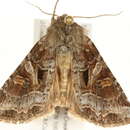Conservation Status
provided by University of Alberta Museums
A fairly common widespread moth; no concerns.
- license
- cc-by-nc
- copyright
- University of Alberta Museums
Cyclicity
provided by University of Alberta Museums
In Alberta adults fly in June and July.
- license
- cc-by-nc
- copyright
- University of Alberta Museums
Distribution
provided by University of Alberta Museums
A western species, reported from Saskatchewan west to BC, south to Idaho and Colorado. In Alberta it is widespread in the cooler and more mesic parklands and southern boreal forest, rare or absent in the dry grasslands.
- license
- cc-by-nc
- copyright
- University of Alberta Museums
General Description
provided by University of Alberta Museums
A medium-size (2.9-3.4 cm wingspan) red-brown and grey brown moth Smaller, darker and less strongly contrasting than tacoma. Ground dull to bright red-brown. Orbicular smaller and more oblong than in tacoma, and usually partially filled with brown scales. The most prominent marking on most specimens is the black claviform, which ranges in size from a small to large distally pointed spot or wedge. The terminal band is grey, suffused to some extent with brown scaling, not wide and clear blue grey as in tacoma. In tacoma, the space immediately below the reniform is usually black and matches the claviform, but in dodii it is red brown brown. The subterminal line is rusty-brown, and forms a shallow w-mark in the lower half in most specimens. The much rarer T. legitima is blue-grey and rust, closer in appearance to tacoma than to dodii. There are good genitalic characters for separating questionable specimens of Trichordestra.
- license
- cc-by-nc
- copyright
- University of Alberta Museums
Habitat
provided by University of Alberta Museums
Mesic meadows, woodland edges and clearings.
- license
- cc-by-nc
- copyright
- University of Alberta Museums
Life Cycle
provided by University of Alberta Museums
Poorly known. Adults are nocturnal and come to light, but have also been taken during daylight hours. There is a single annual brood.
- license
- cc-by-nc
- copyright
- University of Alberta Museums
Trichordestra dodii
provided by wikipedia EN
- license
- cc-by-sa-3.0
- copyright
- Wikipedia authors and editors
Trichordestra dodii: Brief Summary
provided by wikipedia EN
Trichordestra dodii is a species of cutworm or dart moth in the family Noctuidae. It is found in North America.
The MONA or Hodges number for Trichordestra dodii is 10305.
- license
- cc-by-sa-3.0
- copyright
- Wikipedia authors and editors

